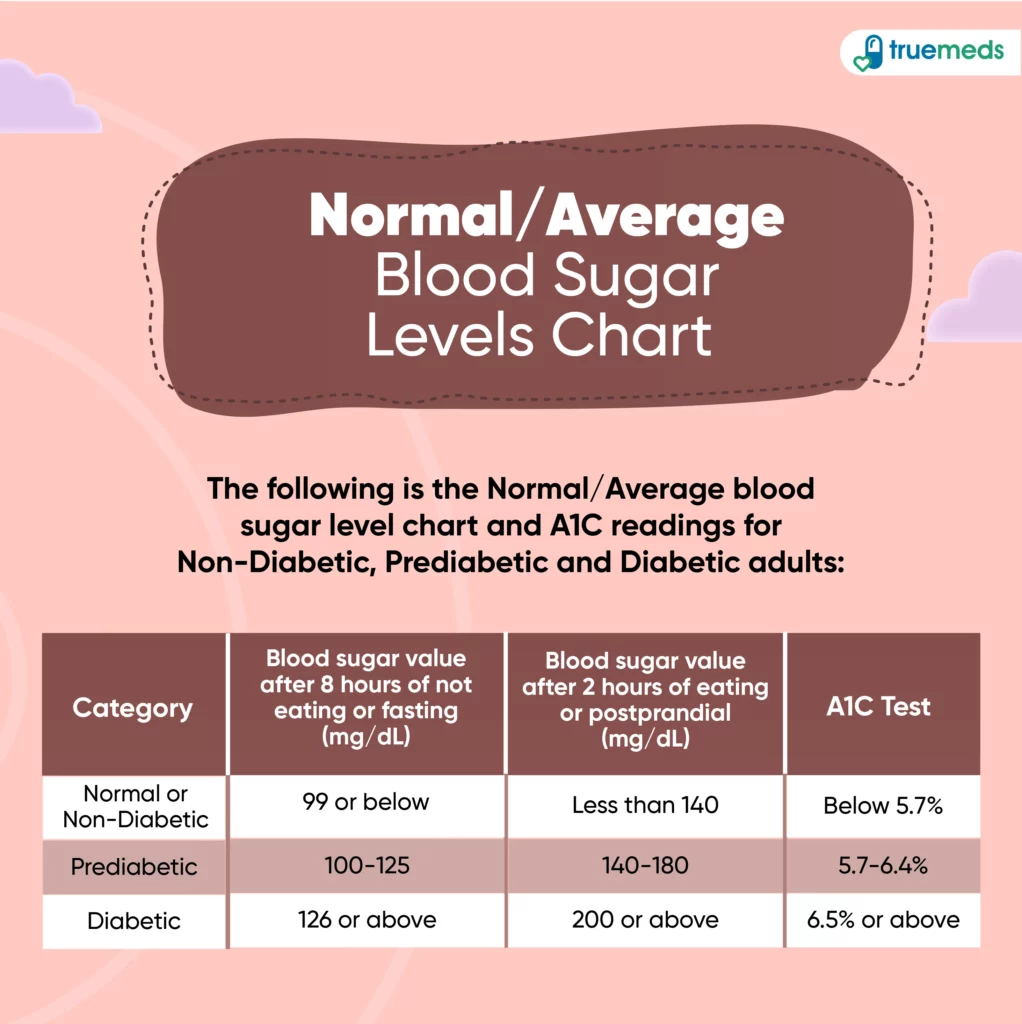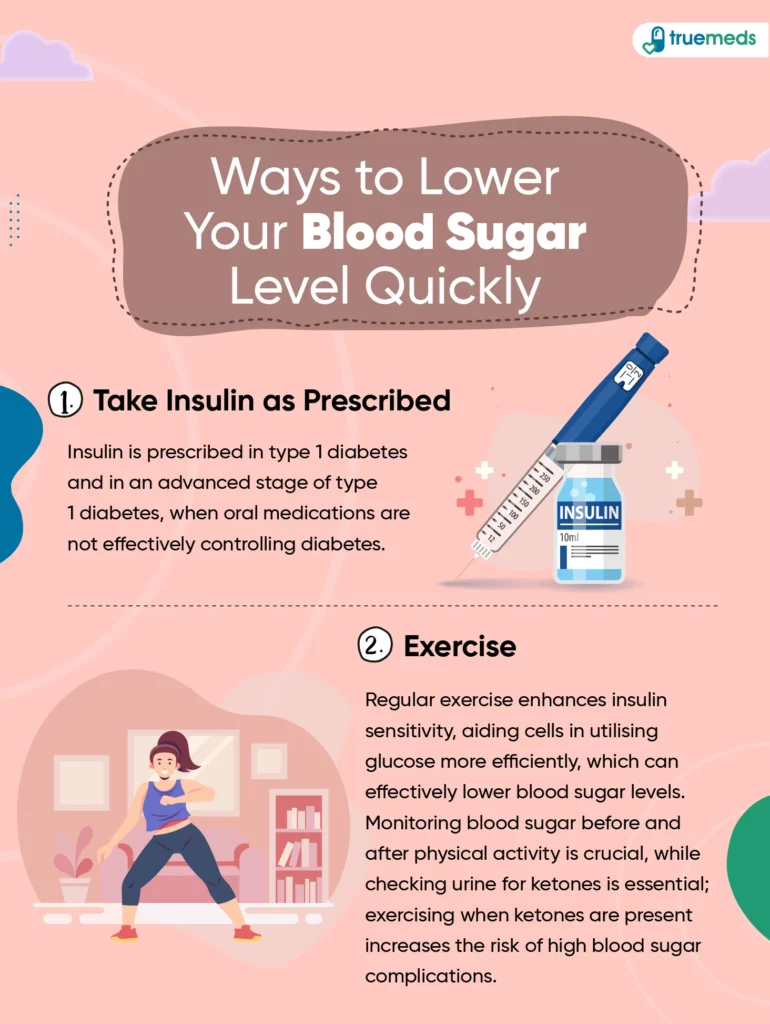Diabetes is a health condition where the body is unable to manage blood sugar (glucose) levels. Insulin, a hormone produced by the pancreas, helps our body to manage blood sugar levels. It helps glucose enter cells, providing energy. In diabetes, the body either doesn’t produce enough insulin (Type 1) or doesn’t use it effectively (Type 2), leading to high blood sugar levels.
Keeping track of blood sugar levels is vital for managing diabetes. Monitoring your sugar levels regularly helps you understand how it responds to food, activity, and medication. This awareness enables timely adjustments in lifestyle and treatment to prevent complications such as heart disease, nerve damage, or kidney failure. Read more to know the normal and dangerous blood sugar levels and how to manage such conditions.
What are Normal Blood Sugar Levels Before and After Eating?
For individuals without diabetes:
- Fasting blood glucose (before meals): 70–99 mg/dL
- Postprandial (2 hours after meals): Less than 140 mg/dL
For individuals with diabetes, the American Diabetes Association (ADA) recommends:
- Fasting: 80–130 mg/dL
Post-meal (2 hours): Less than 180 mg/dLThis balance ensures the body has the energy it needs without causing diabetes complications.
What Level of Blood Sugar is Dangerous?
Blood sugar levels exceeding 180 mg/dL after meals or falling below 70 mg/dL are considered concerning.
Persistent levels above 240 mg/dL or below 54 mg/dL can become dangerous and require immediate medical attention.
Consistently high or low levels can lead to complications, including diabetic ketoacidosis or hypoglycemic coma. Regular monitoring and consultation with a healthcare professional are crucial to maintain safe blood sugar levels.
Dangerous Blood Sugar Levels – High Range
When your blood sugar is 180 to 250 mg/dL mg/dL, it’s considered high. If it falls beyond 250 mg/dL, it is considered a dangerously high sugar level.
High blood sugar, or hyperglycemia, happens when there’s too much sugar in your blood. People with diabetes often experience this, either because their bodies don’t make enough insulin or because their bodies don’t use insulin properly. However, anyone, including those without diabetes, can have temporary spikes in blood sugar due to the following reasons:
- Insufficient insulin
- Missed doses of diabetes medicine
- High carb diet
- Reduced physical activity
- Certain illness
- Emotional stress
- Increased blood sugar levels in the early morning (the dawn phenomenon)
- Somogyi effect, when blood sugar drops overnight, prompts the body to produce more sugar, resulting in higher blood sugar levels in the morning.
In a hyperglycemic state or when your blood sugar is high, you may experience excessive thirst, frequent urination, fatigue, and blurred vision. Children may show signs like frequent bedwetting and excessive hunger. Pregnant individuals may have increased thirst, frequent urination, and a higher risk of gestational diabetes.
If you have diabetes, regularly checking your blood sugar levels with a glucometer can confirm whether it’s too high.
If left untreated, high blood sugar can several cause complications . In adults, it may cause long-term issues like heart disease, kidney problems, nerve damage, and diabetic ketoacidosis. Untreated high blood sugar can impact children’s growth and development, leading to potential learning difficulties. In pregnant women, uncontrolled gestational diabetes can pose risks to both the mother and baby. Complications may include a higher chance of birth defects, preterm birth, and other pregnancy-related issues.
It’s essential to address high blood sugar promptly. Taking your prescribed medications or insulin. Eating a balanced diet, staying physically active, and managing stress are key components of keeping blood sugar levels in check.
Dangerous Blood Sugar Level – Low Range
Blood sugar levels are considered low when they fall below 70 mg/dL. If they drop even more, below 54 mg/dL, it is considered dangerously low, and it might cause you to faint (pass out). Low blood sugar levels require immediate medical treatment. Low blood sugar level, or hypoglycemia, is commonly experienced by individuals with diabetes, particularly those using insulin. Causes of hypoglycemia include:
- Skipping meals
- Overdose of insulin or diabetes medication
- Excessive alcohol
Strenuous exercise without adjusting food intakeYou may experience shakiness, sweating, irritability, confusion, and dizziness if you have low blood sugar. Severe cases can result in unconsciousness or seizures. Children might display irritability and difficulty concentrating.
Regular blood sugar monitoring with a glucometer, especially for individuals with diabetes, helps detect and address low levels.
Untreated low blood sugar can lead to complications in adults, children, and during pregnancy. In adults, it may cause cognitive impairments, mood changes, and in severe cases, seizures or loss of consciousness. Children may experience learning difficulties, behavioral changes, and, in extreme situations, seizures. In pregnancy, untreated low blood sugar poses risks to both the mother and baby. Complications may include preterm birth, developmental issues, and in rare cases, fetal distress.
To prevent complications, it’s important to have a proactive approach. Regular blood sugar monitoring, adherence to medication schedules, adjusting medication doses and maintaining a consistent eating schedule can help reduce the chances of low blood sugar.
If you experience any symptoms of low blood sugar, its best to consume quick-acting carbohydrates, such as glucose tablets, a tablespoon of sugar, honey, or syrup, hard candy, regular soda, juice or sugary foods, to raise blood sugar levels.
Avoid having carbs high in fibre, like beans or lentils, and carbs that contain fat, such as chocolate. Fiber and fat can slow down the absorption of sugar, making it less effective.
Normal/Average Blood Sugar Levels Chart

The following is the Normal/Average blood sugar level chart and A1C readings for Non-Diabetic, Prediabetic and Diabetic adults:
| Category | Blood sugar value after 8 hours of not eating or fasting (mg/dL) | Blood sugar value after 2 hours of eating or postprandial (mg/dL) | A1C Test |
| Normal or Non-Diabetic | 99 or below | Less than 140 | Below 5.7% |
| Prediabetic | 100-125 | 140-180 | 5.7-6.4% |
| Diabetic | 126 or above | 200 or above | 6.5% or above |
What is A1C Test and its Role in Managing Diabetes?
Unlike the glucometers, which show just a quick reading, the A1C test measures average blood sugar levels over the past 2-3 months. This test is of extreme significance in diabetes care. It offers a comprehensive perspective on how well you are managing diabetes. A1C test measures the average amount of sugar attached to your red blood cells during this time. The levels of A1C include:
- <5.7%: Normal
- 5.7–6.4%: Prediabetes
≥6.5%: DiabetesThe goal for diabetics should be to keep the A1C level within a target range, usually below 7%. This target reflects optimal blood sugar control, reducing the risk of diabetes-related issues such as heart disease, kidney problems, and nerve damage. Regular monitoring of A1C levels allows your doctor to change your medications.
Getting this Diabetes test done is simple. The A1C test does not require fasting and is typically done every 3–6 months depending on diabetes control.
Ways to Lower Your Blood Sugar Level Quickly
Lowering blood sugar quickly involves a combination of lifestyle adjustments and immediate actions. Here are quick ways to help bring down blood sugar levels:

1) Take Insulin as Prescribed
Insulin is prescribed in type 1 diabetes and in an advanced stage of type 2 diabetes, when oral medications are not effectively controlling diabetes. It may also be used during gestational diabetes and in severe cases of hyperglycemia. Insulin facilitates the entry of glucose into cells, which can be used for energy. When administered, insulin quickly lowers blood sugar levels by enabling cells to absorb glucose.
2) Exercise
Exercise can have a lasting impact, improving insulin sensitivity 24 hours after physical activity. Physical activity improves the body’s response to insulin, making cells more efficient in using glucose. This increased sensitivity means insulin can work more effectively to lower blood sugar. However, it’s important to record your blood sugar level before and after physical activity.
If your blood sugar exceeds 240 mg/dL, check your urine for ketones. If there are ketones, don’t exercise because it can increase your blood sugar. Exercising if there are ketones in your urine can increase the risk of having high blood sugar levels. If your ketones are high, performing gentle exercises like walking is better.
Additionally hydrate well: Drink plenty of water to help flush excess sugar via urine.
Eat Low-Glycemic Foods: To prevent spikes, focus on foods like non-starchy vegetables, legumes, and whole grains.
Takeaway
Maintaining healthy blood sugar levels is key to preventing diabetes complications. For people with diabetes:
- Fasting glucose: <126 mg/dL
- Post-meal glucose: <200 mg/dL
- A1C goal: <7%
>240 mg/dL may require urgent insulin correction, while <54 mg/dL demands quick action with fast-acting carbohydrates.
Long-term management involves medication, lifestyle modifications, and regular monitoring. Prompt responses to fluctuations are essential to avoid complications such as diabetic ketoacidosis, seizures, or coma.To effectively manage your diabetes and online order medicines, you can download the Truemeds App!
Frequently Asked Questions (FAQs)
An A1C ≥6.5% indicates diabetes. Levels ≥8% suggest poor control and increased risk of complications.
Yes, a blood sugar level of 400 is dangerously high. It requires immediate medical attention to avoid complications and address the severe hyperglycemic state.
Blood sugar, below 54 mg/d, is considered dangerous, potentially leading to fainting or loss of consciousness. Immediate treatment and assistance is needed in such cases.
Yes, dangerous blood sugar levels can often be prevented through a combination of a balanced diet, regular physical activity, and medication as prescribed by a healthcare provider. Monitoring blood sugar levels regularly and maintaining a healthy lifestyle are crucial steps in prevention.
When your blood sugar is too high, you may feel symptoms such as increased thirst, frequent urination, fatigue, blurred vision, and headaches. In severe cases, you might experience confusion or difficulty concentrating.
You should go to the ER if your blood sugar levels are consistently above 300 mg/dL, or if you experience symptoms of ketoacidosis, such as nausea, vomiting, abdominal pain, rapid breathing, or a fruity-smelling breath, as these can indicate a medical emergency.
A healthy blood sugar level for non-diabetics typically ranges from 70 to 99 mg/dL when fasting and less than 140 mg/dL two hours after eating. Maintaining these levels can help prevent the risk of developing diabetes.
You can manage your blood sugar levels effectively by eating a balanced diet rich in fiber, whole grains, and lean proteins, exercising regularly, monitoring your blood sugar levels, and taking medications as prescribed. Additionally, managing stress and getting enough sleep are also important factors.
References
- Mouri, M., & Badireddy, M. (2023, April 24). Hyperglycemia. StatPearls – NCBI Bookshelf. https://www.ncbi.nlm.nih.gov/sites/books/NBK430900/
- Umpierrez, G. E., Davis, G. M., ElSayed, N. A., Fadini, G. P., Galindo, R. J., Hirsch, I. B., Klonoff, D. C., McCoy, R. G., Misra, S., Gabbay, R. A., Bannuru, R. R., & Dhatariya, K. K. (2024). Hyperglycemic crises in adults with Diabetes: a consensus report. Diabetes Care, 47(8), 1257–1275. https://doi.org/10.2337/dci24-0032
- Tsichlaki, S., Koumakis, L., & Tsiknakis, M. (2022). Type 1 Diabetes Hypoglycemia Prediction Algorithms: Systematic Review. JMIR Diabetes, 7(3), e34699. https://doi.org/10.2196/34699
- Nakhleh, A., & Shehadeh, N. (2021b). Hypoglycemia in diabetes: An update on pathophysiology, treatment, and prevention. World Journal of Diabetes, 12(12), 2036–2049. https://doi.org/10.4239/wjd.v12.i12.2036

Leave a Reply